If you fold the Philippine map twice, you will find Masbate at the center. Although part of the Bicol region, Masbate connects with many ports in the Visayas. Last year, I was able to go to Ticao island in Masbate via Donsol, Sorsogon. This time, our group took a ferry from Roxas City to Balud, Masbate. Upon arrival in Balud, I noticed the people spoke Hiligaynon without the intonation. Exploring almost the entire province, I noticed different languages spoken in every town. It appears that the language spoken in a particular area depends on the province closest to it. So, Hiligaynon, Cebuano, Waray, and Bicol are spoken in different places. In Masbate City, a mixture of all the languages called Minasbate is spoken. Masbateños consider themselves as Bicolanos. In fact, Masbate used to be part of Albay and Sorsogon.
Old Settlement
It seems that many Masbateños have migrated from other provinces but history tells us that Masbate is one of the oldest settlements in the country. Geologically, it is also the oldest. During the Spanish times, Mobo was a galleon shipyard and San Jacinto in Ticao was a port of the Manila-Acapulco Galleon Trade.
Archaeological And Ecological Landscape
In Monreal, Ticao, two limestone tablets that contain Baybayin script were found by students who used it to scrape mud off their shoes. It is now in the National Museum. Ticao is known as an archaeological landscape with hundreds of pre-colonial artifacts such as burial jars, jade beads, human face rock statues, and petrographs.
Ticao is also an ecological sanctuary. It is home to Bongsanglay Natural Park which is a protected area of mangrove forests and swamps. In San Jacinto, Ticao and San Pascual, Burias, there are houses converted into nesting grounds of swiftlets which produce the expensive Nido soup.
Manta Bowl, Diver Destination
Ticao is known to divers as the Manta Capital of the Philippines. Manta Bowl is a small seamount located seven kilometers offshore. Divers usually come from whale watching in Donsol, Sorsogon. Ticao Pass, one of the richest waters in the Philippines, is host to dolphins, turtles, and an array of sharks. These marine animals pass this area because it is a cleaning station where parasites and dead skin are removed by cleaning wrasse.
Three Major Islands
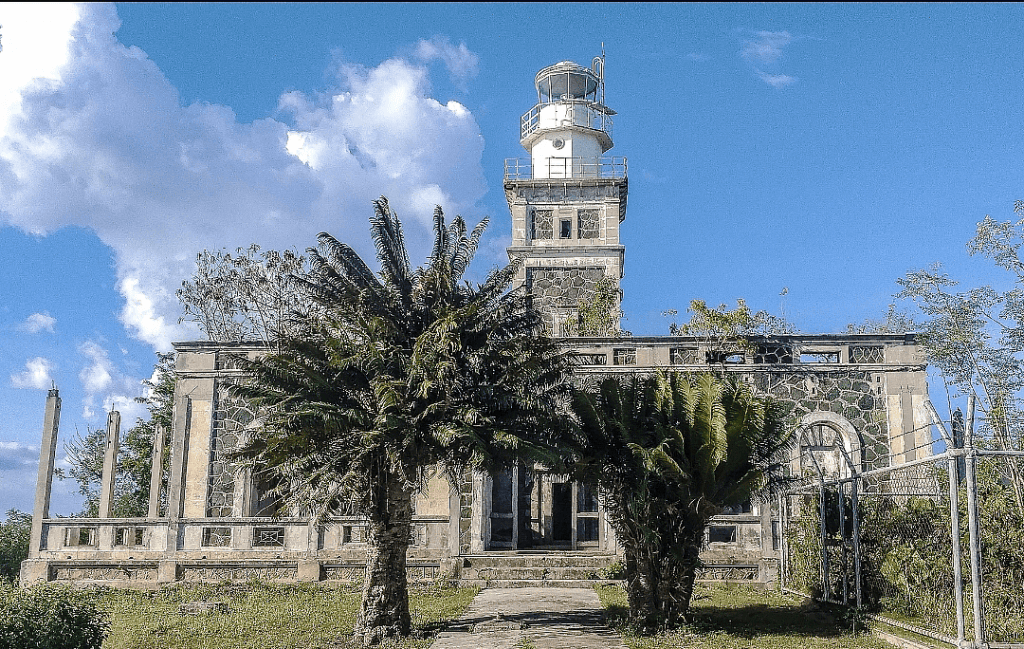
Masbate consists of three major islands: Masbate, Ticao, and Burias. Masbate is the biggest where you will find Masbate City. Our nine-day expedition starts in Balud after a three-hour ferry ride from Culasi, Roxas City. When we arrived in Balud, we immediately took a boat to Jintotolo Island. It was fiesta time so the whole island was bedecked with colorful buntings but what made this trip memorable was a trek to Jintotolo Lighthouse. Standing on the highest point of the island, it was a sight to behold. I bravely climbed the spiral staircase to get a spectacular view of the Visayan Sea while the others flew their drones. It has a square tower with an octagonal podium that houses the lamp.
After the island fiesta, we went back to Balud for a river cruise at Suba Lumawig Adventure Park. This is a community-based tourism effort which is worth visiting. The four-km river has an extensive mangrove area which runs through an estuary. Delectable seafood was served while cruising. Masbate is absolutely an emerging seafood capital.
Cowboy Country
Dried up, we tried playing cowboys by riding horses at the Sese Brahmans Ranch. Owned by Judge Sese, this ranch breeds the Brahman type of cow. Using the ratio of one hectare per cow, you can visualize how expansive this ranch is. This is cowboy country!
Fancy yourself as John Wayne? Suit up at Rodeo Leathercraft Store in Masbate City, complete with boots, hats, belts, buckles, wallets and other leathercraft. Be ready for the Rodeo Festival which happens annually and includes activities such as load carrying relay, carambola, cattle wrestling and the popular bull riding.
For your mancave, there’s Handumanon Arts and Crafts where the bull’s skull is made into a conversational art piece. The owner, Virgilio Natural, is a true-blue Masbateño, being the founder of a mountaineering club.
Dragon Fruit, Livestock
Masbate is more than just Marlboro country. Other sites include Masbate Safari and Agricultural Complex. This impressive farm plants 23 varieties of dragon fruit. They also produce mangoes and have a vermi composting facility. For local color, we were fortunate to witness the Curvada Livestock Market where cows, pigs, and horses were being traded. It was a muddy affair but a truly authentic experience.
Farm Tourism
At another farm, in Uma Koinonia, organic fertilizer is used to produce rice and lettuce. They also have a poultry farm and a fish pond. Aside from being a TESDA accredited farm school, Uma Koinonia offers overnight accommodations in artistically interiored cottages amid a contoured garden landscape.
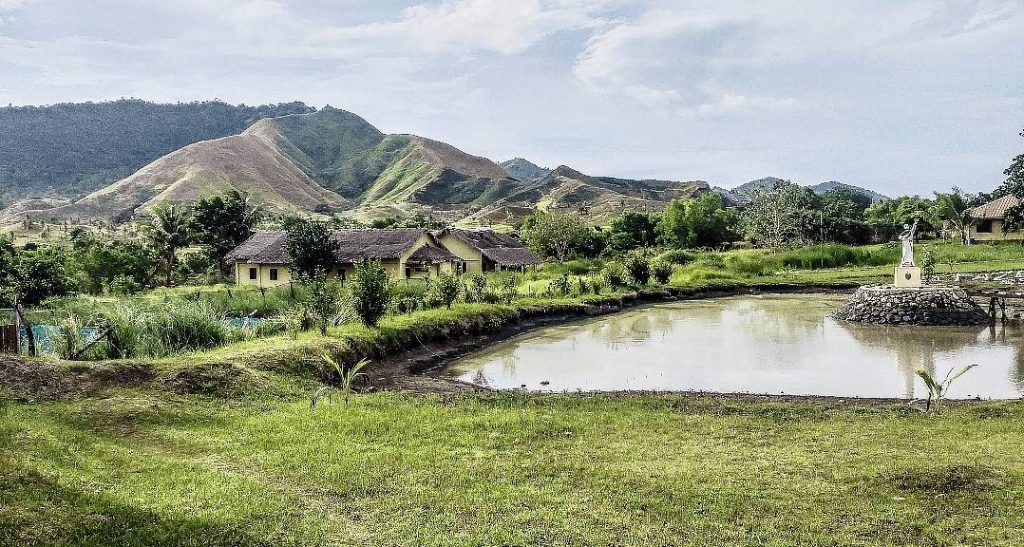
The cottages are atop a hill with spectacular views. This, by far, is the best farm tour I’ve ever been to. It is run by Born Again Christians. At Facenda de Esperanza in Milagros, a Catholic mission runs a nature-oriented rehabilitation center for people who want to release their addictions. In Masbate City, pilgrims flock to Villa Bayot on Fridays to venerate the Santo Entierro.
The Islands
Masbate is one of two provinces in the Bicol Region which is not part of the Bicol Peninsula. The three main islands, sandwiched between the Sibuyan and Visayan Sea, are vital cogs in the nautical highway which connects Luzon with Visayas. It is a beach paradise with many freediving and scuba diving sites.
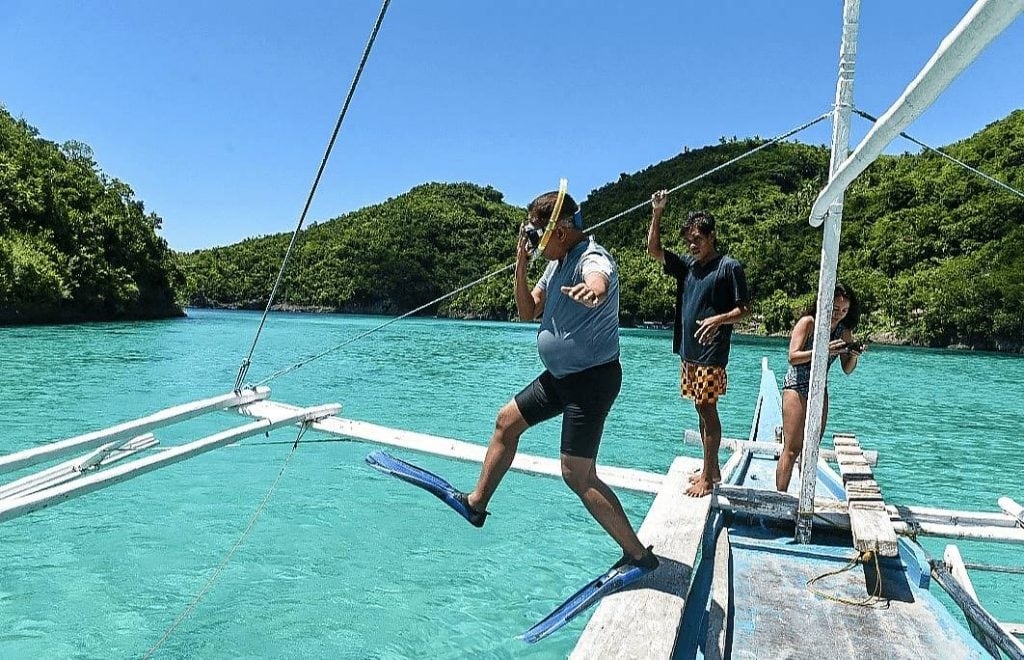
Off the coastline of Ticao is Halea Nature Park where you can snorkel freely with baby sharks. At Lapus-lapus, we couldn’t resist jumping off the boat into the turquoise waters. At noon, we anchored at Borobongkaso Rock Formations for some photo opportunities. I was there last year and some of the rocks seem to have been chopped off by natural forces. The highlight of the day was still the Catandayagan Falls. This natural wonder is one of the few waterfalls in the world which drops off to the ocean. It was the last part of the day and it seemed fitting to rinse off the sea water by going under the fresh stream of water.
Another day of island hopping brought us to Guinlobngan Island, Isla Florencia, and Buntod Reef Marine Sanctuary. We had to trudge in knee-deep water for about half a kilometer to reach Kurokabayo which is the longest sandbar in Bicol at 2.8 km. We had lunch at the beautiful Playa de Gregorio before proceeding to Balangingi Island. At sunset, we were at Matayum Lagoon. This is where the Bagat Dagat Festival is held every June 23-24 featuring fluvial parade, beach volleyball, dragon boat, motor boat race, tattoo contest, line fishing, kite flying, and fire dancing contest.
Snake Island
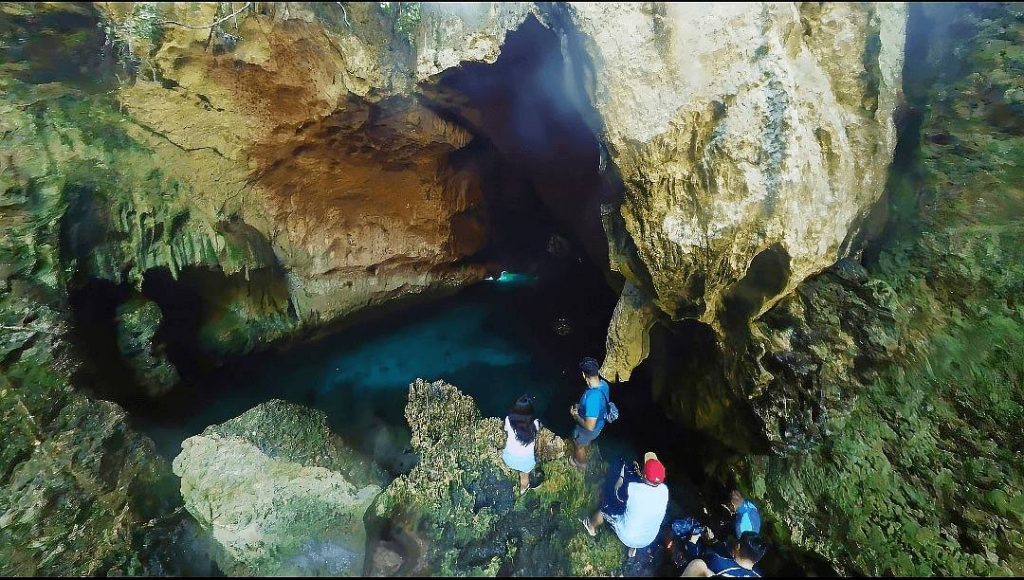
I was excited to go back to my favorite Ticao Island Resort. Last year, I wasn’t able to dive with the mantas because of lack of time. Before we went to Ticao, we stopped at Snake Island. Initially, I thought the island was shaped like a snake. No, it wasn’t and it wasn’t an ordinary snorkelling stop. The cave island was littered with sea snakes! We had to tread carefully on jagged stones. Our guide said there was no antidote for the snake bite so we moved carefully without disturbing the sea snakes. On the way to the cave lagoon, I needed some push to do some rock climbing. At the edge of the small lagoon, I put my cell phone inside my dry bag which functioned as a floating device before I jumped in the water. Once in the water, we had to watch out for swimming sea snakes but our objective then was to get out of the sea cave through a small opening before high tide sets in. To make things more thrilling, there were bats flying over the small cave opening. We swam through the small opening and got hit on the head by flying bats. I dove to avoid the bats but when I resurfaced, I saw one bat swimming! Out in the open sea, with no fins, we hung on to some big stones encrusted with corals and waited for the banca to pick us up. After that adrenaline rush, we arrived at Ticao Island Resort early in the evening. Alas, I missed diving with the mantas again. Perhaps, next time around.
The following day was more relaxing. Tourism officials told us we were going to a beach that looked like Boracay in the ’90s. I had high expectations because I was in Boracay in the ’80s. The road trip to Aroroy was worth it. We had a sumptuous seafood lunch at Tinigban Beach Club Resort. The sand and sea were reminiscent of the old Boracay minus the crowd. The resort has a swimming pool and a jet ski for water sports.
Burias Island

On the last day of the expedition, we took a night ferry to Burias, the northernmost island of Masbate Province. We arrived as the town was preparing for their annual Isla Rancho Festival. There was already a festive atmosphere in San Pascual Town with a trade fair and a beauty pageant. We walked around the town and explored the Nazareno ancestral house and St. Paschal Baylon Church. We were up for another island hopping on the last day but what lured my olfactory sense was the smell of dried fish, particularly dilis, galunggong, and dalagang bukid.
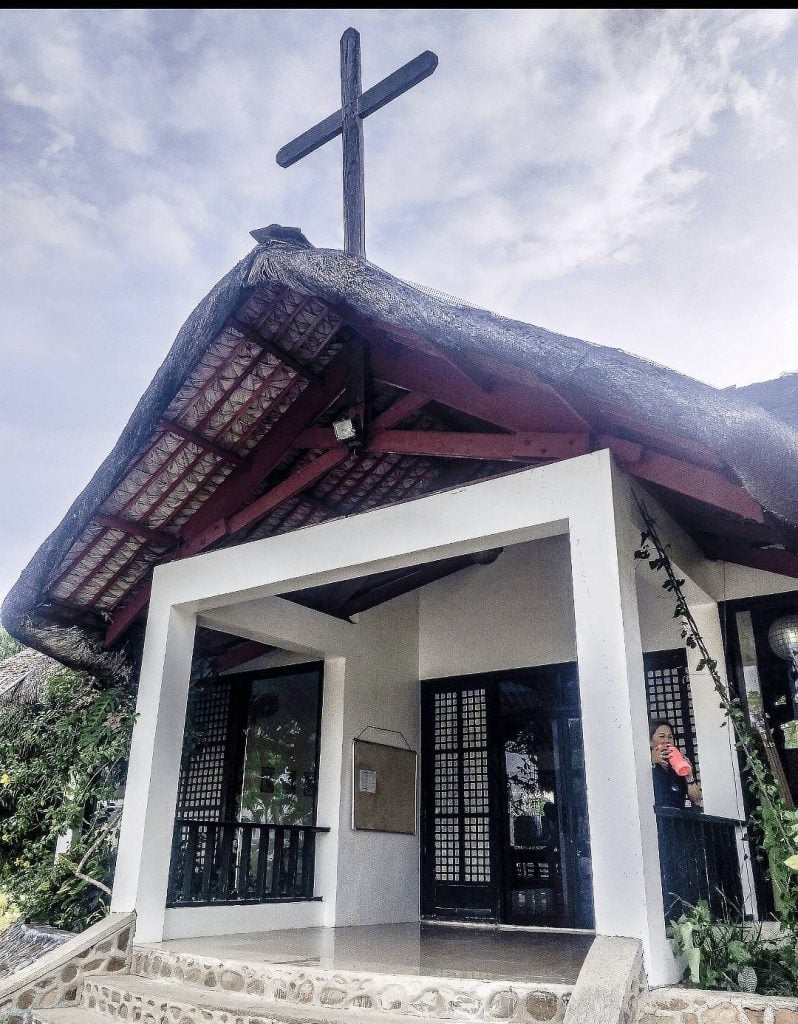
On our last day, we visited three more enchanting islands. Animasola was a photographer’s favorite with its rock walls. Tinalisayan has a long sandbar while Sombrero has nipa accommodations. On our way back to mainland Burias, we passed by Templo Island. It was a mysterious-looking rock island which didn’t seem to have a beach. There is a white cross, the origin of which is unknown. Later I learned that intrepid travellers would go there to do some cliff diving. True to its name, Templo Island is also home to ancient burial jars, adding more to its mystery.
After the nine-day journey, the mystery of Masbate was partly unravelled. It is no longer the wild, wild, west of local politics but is now an abode of peace. If you unfold the Philippine map, you will find a group of islands as if spreading its veins to many parts of the archipelago and thereby asserting itself as an aquacentric destination. Make it Masbate! Mas bet ko Masbate!
Thank you Tourism Promotions Board and the Masbate Provincial Tourism Culture & Arts Office, Landline: (056) 578-0938, FB Page: Masbate Provincial Tourism Culture and Arts Office, Email: ( masbateprovincialtourism@gmail.com) for making this trip truly memorable.
* * *
JP Ordoña (Manilakad) leads Manilakad Walks in Intramuros, Binondo, Quiapo and more. Let him guide you to several walking destinations in Manila. Manilakad (JP Ordoña) can be reached on Facebook Messenger or through text at 0916-3597888.
